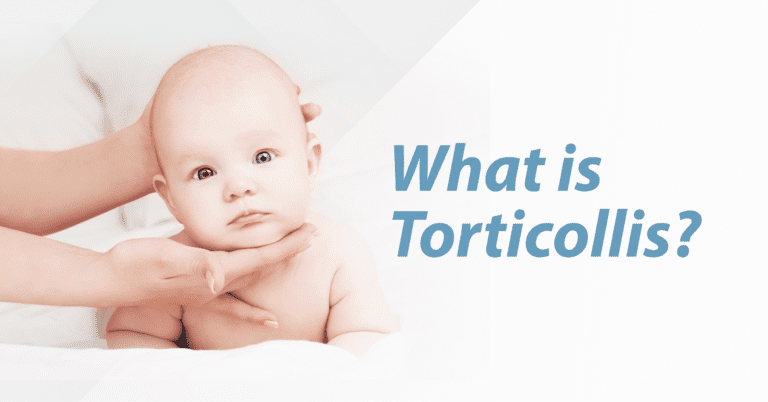
What is Torticollis in Babies?
This content was updated for accuracy and relevance on June 9, 2023
Congenital torticollis or “wry neck” affects every 1 in 250 newborns. This condition occurs when an infant holds his/her head tilted to one side and has difficulty turning their head. In this comprehensive guide, we will explore the causes, symptoms, and effective physical therapy interventions to assist in the optimal development and well-being of your precious little ones.
What causes torticollis in babies?
Congenital torticollis affects every 1 in 250 newborns. Congenital torticollis or ‘wry neck’ occurs when an infant holds his/her head tilted to one side and has difficulty turning their head. An infant becomes accustomed to tilting their head to one side due to a shortening of the baby’s neck muscles on that side, specifically the sternocleidomastoid muscle. This sternocleidomastoid muscle extends from the skull behind the ear, diagonally down to the front of the baby’s neck, attached to the collar and chest bones. This tight muscle causes the baby’s head to tilt towards and rotate away from the affected tight neck muscle, further contributing to a twisted neck.
The exact cause of infant torticollis is unknown, however, the most often cited cause is due to the child’s abnormal positioning in utero and then continued throughout the baby’s birth.
What are the signs of torticollis in babies?
Babies with pediatric torticollis navigate their early days much like their peers, with one exception—their challenges arise during activities that require head rotation. Around the age of 2 to 4 weeks, a baby grappling with muscular torticollis may find certain actions or movement, such as turning their head, a tad more demanding than their counterparts.
Here are common signs of babies with congenital torticollis:
- Tilted head to one side and chin to the other side
- Restricted movement of the head and neck
- Shoulder asymmetry, with one side appearing higher
- Tightness or stiffness in the neck muscles
- Swelling in the neck muscles
- Presence of a small pea-sized lump in the neck muscles
- Uneven or asymmetrical facial features
These are common signs and symptoms of babies with acquired torticollis:
- Head tilting to one side and chin tilting to the other side
- Limited movement of the baby’s head and neck
- Shoulder asymmetry, with one side appearing higher
- Neck muscle tightness or stiffness
- Swelling in the neck muscles
- Severe neck pain
- Head tremors
- Headaches
What are the effects of torticollis in babies?
The result of this shortened neck muscle often leads to activity limitations. The effects can vary, but may include:
- Difficulty keeping the baby’s head in midline
- Facial asymmetry of reflexes
- Neglect of the hand (on the same side)
- Decreased visual awareness of the visual field
- Limited range of chin rotation
- Interference with the symmetric development of the baby’s head and neck reactions
- Possibly delayed and interfered rolling to the side
How can it be treated?
Pediatric torticollis can be successfully treated by rehabilitation physical therapy, especially if addressed early on. In fact, for the best results, a baby with torticollis can start treatment as early as 3-6 months of age. If a baby’s torticollis goes undiagnosed, infants later in development may need a helmet to address positional consequences such as positional plagiocephaly, or flat head syndrome which is essentially flattening of the baby’s head shape.
Physical Therapy & Torticollis
Physical therapy for torticollis can successfully educate the parents on the diagnosis, plan of care, home program and goals of physical therapy. The goals of pediatric physical therapy as a form of treatment for infants with acquired torticollis include:
- Normalizing infant’s passive range of motion in the neck and shoulder region with specific stretching exercises
- Minimizing asymmetry in spontaneous positional and movement preferences
- Addressing muscle tightness
- Parent education on the proper positioning and toy placement
Simple Exercises To Help Encourage Movement
- Tummy time: For any baby, tummy time is essential. But, for babies experiencing any torticollis symptom, this activity helps strengthen the neck and shoulder muscles, as well as prepares the baby to crawl
- Sleeping position: Babies prefer to look outward as opposed to inward, meaning that when placed in their crib, position the baby on his or her back with their head facing the wall. Your baby will naturally want to turn his or her head to face the room, which will help strengthen the tight neck muscle over time
- Feeding position: Whether feeding with a bottle or by breast, change up the feeding position to exercise the neck muscle. This will prevent the baby from becoming too comfortable with a favored side.
Addressing torticollis in infants
Early prevention and diagnosis, through pediatrician awareness and parent education, is key in the successful treatment of infants with moderate to acute torticollis. Contact an Ivy Rehab clinic near you to discuss your child’s torticollis symptoms and receive the proper treatment by a trusted pediatrician and physical therapist.
The medical information contained herein is provided as an information resource only, and does not substitute professional medical advice or consultation with healthcare professionals. This information is not intended to be patient education, does not create any patient-provider relationship, and should not be used as a substitute for professional diagnosis, treatment or medical advice. Please consult with your healthcare provider before making any healthcare decisions or for guidance about a specific medical condition. If you think you have a medical emergency, call your doctor or 911 immediately. IvyRehab Network, Inc. disclaims any and all responsibility, and shall have no liability, for any damages, loss, injury or liability whatsoever suffered as a result of your reliance on the information contained herein.